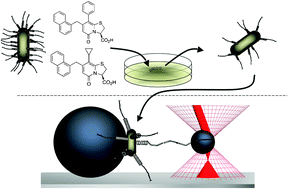The infectious ability of uropathogenic Escherichia coli relies on adhesive fibers, termed pili or fimbriae, that are expressed on the bacterial surface. Pili are multi-protein structures that are formed via a highly preserved assembly and secretion system called the chaperone-usher pathway. We have earlier reported that small synthetic compounds, referred to as pilicides, disrupt both type 1 and P pilus biogenesis in E. coli. In this study, we show that the pilicides do not affect the structure, dynamics or function of the pilus rod. This was demonstrated by first suppressing the expression of P pili in E. coli by pilicide treatment and, next, measuring the biophysical properties of the pilus rod. The reduced abundance of pili was assessed with hemagglutination, atomic force microscopy and Western immunoblot analysis. The biodynamic properties of the pili fibers were determined by optical tweezers force measurements on individual pili and were found to be intact. The presented results establish a potential use of pilicides as chemical tools to study important biological processes e.g. adhesion, pilus biogenesis and the role of pili in infections and biofilm formation.

You have access to this article
 Please wait while we load your content...
Something went wrong. Try again?
Please wait while we load your content...
Something went wrong. Try again?


 Please wait while we load your content...
Please wait while we load your content...